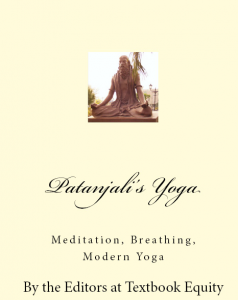 “Patanjali’s Yoga – Meditation, Breathing, Modern Yoga” should be part of every Yoga student’s library.
“Patanjali’s Yoga – Meditation, Breathing, Modern Yoga” should be part of every Yoga student’s library.
As students of yoga progress in their physical practice, so too should they come to comprehend the spiritual sources of yoga breathing techniques and poses.
This book contains textual contents (some modern, some written 1,500 years ago), a glossary, and an index. Its main purpose is to allow the reader to broaden their understanding of the Yoga Sutras and how they are related to modern yoga practices. These sutras may be the inspiration for those who later created the various yoga asanas and related practices, so that they, too, might join in spiritual union with the Eternal. Of course, you may use this book to study each sutra academically as a religious philosophy.
See below for the table of contents.
– Namaste!
Questions? Write Editors@textbookequity.org
Download e-Book version, Free (PDF, 1.8MB)
By at Amazon.com
Maybe brush-up on your knowledge of Human Biology, too. Free PDF (color, 28MB).
Table of Contents
I. Modern Yoga = ƒ1(Ancient Sutras in Sanskrit
1. Is Yoga Safe or effective?
2. So, Who Practices Yoga?
3. Who is Patanjali?
4. What are the Yoga Sutras?
5. What do the Yoga Sutras say?
6. How are the Yoga Sutras related to breathing?.
7. What is the relationship of the Sutras to yoga poses?
8. Who is Charles Johnston?
II. Appendix A: The Yoga Sutras of Patanjali “The Book of the Spiritual Man”
1. Introduction to Book I
2. Book I (The Book of Spiritual Consciousness).
3. Introduction to Book II
4. Book II (The Book of the Means of Soul Growth)
5. Introduction to Book III
6. Book III (The Book of Spiritual Powers)
7. Introduction to Book IV
8. Book IV (The Mechanism of Salvation)
III. Appendix B:: The Yoga Sutras of the Patanjali (No Commentary
1. Book I (The Book of Spiritual Consciousness)
2. Book II (The Book of the Means of Soul Growth)
3. Book III (The Book of Spiritual Powers)
4. Book IV (The Mechanism of Salvation)
IV. Yoga Sutra Glossary
V. Additional Notes and References


 “Patanjali’s Yoga – Meditation, Breathing, Modern Yoga” should be part of every Yoga student’s library.
“Patanjali’s Yoga – Meditation, Breathing, Modern Yoga” should be part of every Yoga student’s library.